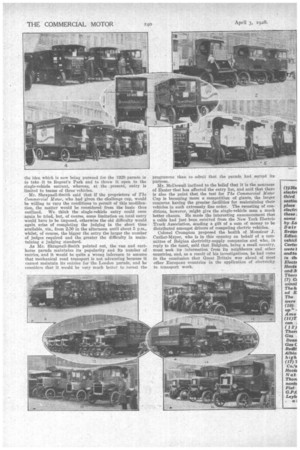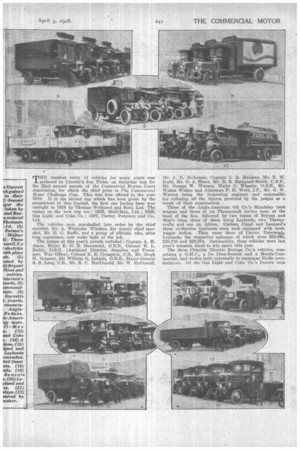THE FIRST PARADE OF THE YEAR.
Page 57

Page 58

Page 59

Page 60

If you've noticed an error in this article please click here to report it so we can fix it.
A Reduced Entry, but Sustained Enthusiasm Amongst Drivers. The Future of the Parade in the Balance.
AT the luncheon of the judges and a few guests' which was held prior to the parade, Mr. W. McDowell, chairman of the London and Home Counties Parade Committee and vice-chairman of the Association, presided.
Mr. Shrapne,ll-Smith, who proposed the toast of "The Parade," dealt with the difficulties which have for the past year incited the question as to whether the parade had served its purpose and, therefore, whether it should be discontinued. He said that, last year, the fact that Lincoln's Inn Fields is now a public parking place introduced considerable difficulty in the formation of the vehicles on parade, and this had been the main reason for instigating a review of the situation.
It had been hoped that the Army Council would give permission for the Horse Guards Parade to be used, but thix was not found to be possible. The difficulties of last year• had no doubt helped to reduce the number of competing vehicles from 160 to the 96 on parade on this occasion. and the idea which is now being pursued for the 1929 parade is to take it to Regent's Park and to throw it open to the single-vehicle entrant, whereas, at the -present, entry is limited to teams of three vehicles.
Mr. Shrapnell-Smith said that if the proprietors of The Commercial Motor, who had given the challenge cup, would be willing to vary the conditions to permit of this modification, the matter would be considered from the basis thus outlined. We think the single-vehicle entry could once again be tried, but, of course, some limitation on total entry would have to be imposed, otherwise the old difficulty would again arise of completing the judging in the short time available, viz., from 2.30 in the afternoon until about 5 p.m., whilst, of course, the bigger the entry the larger the number of judges required and the greater the difficulty in maintaining a judging standard.
As Mr. Shrapnell-Smith pointed out, the van and carthorse parade maintains its popularity and its number of entries, and it would be quite a wrong inference to assume that mechanical road transport is not advancing because it cannot maintain its entries for the London parade, and he considers that it would be very much better to recast the programme than to admit that the parade had served its purpose.
Mr. McDowall inclined to the belief that it is the nearness of Easter that has affected the entry list, and said that there is also the point that the test for The Commercial Motor Cup is becoming more a competition of giants, the larger concerns having the greater facilities for maintaining their vehicles in such extremely fine order. The recasting of conditions, however, might give the single-vehicle man a much better chance. He made the interesting announcement that a cable had just been received from the New York Electric Truck Association, sending a gift of a sum of money to be distributed amongst drivers of competing electric vehicles. Colonel Crompton proposed the health of Monsieur J. Carlier-Mayer, who is in this country on behalf of a committee of Belgian electricity-supply companies and who, in reply to the toast, said that Belgium, being a small country, must seek its information from its neighbours and other countries, and, as a result of his investigations, he had come to the conclusion that Great Britain was ahead of most other European countries in the application of electricity to transport work. TlIE smallest entry of vehicles for many years was gathered in Lincoln's Inn Fields on Saturday last for the 22nd annual parade of the Commercial Motors Users Association, for which the chief prize is The Commercial Motor Challenge Cup. This was first offered in the year 1910. It is the second cup which has been given by the proprietors of this journal, the first one having been won outright in 1024 by Thomas Wethered and Sons, Ltd. The names on the new cup are : 1925, Shell-Mex, Ltd.; 1926, Gas Light and Coke Co.; 1927, Carter, Paterson and Co., Ltd.
The vehicles were marshalled into order by the chief marshal, Mr. A. Whalesby Windsor, his deputy chief marshal, Mr. E. C. Ruffle, and a group of officials, who, after long experience, now make light of the job.
The judges at this year's parade included: Captain A. H. Amor, Major E. C. E. Beaumont, 0.B.E., Colonel B. L. Beddy, D.S.O. (Assistant Director, Supplies and Transport. War Office), Colonel R. E. Crompton, C.B., Mr. Hugh H. Gregory, Sir William G, Lobjoit, 0.B.E., Major-General S. S. Long, C.B., Mr. R. C. MacDonald, Mr. W. McDowall, Mr. A. E. McKenzie, Captain J. It. Maidens, Mr. E. W. Rudd, Mr. G. J. Shave, Mr. E. S. Shrapnell-Srnith, C.B.E., Mr. George W. Watson, Major C. Wheeler, 0.B.E., Mr. Walter Wolsey and Alderman F. H. Wort, J.P., Mr. G. W. Watson being the inspecting engineer and responsible for collating all the figures provided by the judges as a result of their examination.
Three of the Anglo-American Oil Co.'s Maudslay tank wagons and three of its Thornycroft lorries were at the head of the line, followed by two teams of Bryant and May's vans, three of these being Leylands, two Thornycrofts and one an Albion. Oarliss, Capel and Leonard's three ex-Service Leylands were each equipped with tankwagon bodies. Then came three of Carter, PatersoK's, Leylands, the respective mileages of which were 258,842, 230,110 and 228,374. Incidentally, these vehicles were last year's winners, fated to win again this year.
The three Chloride Electric Storage Co.'s vehicles, comprising a G.M.C., a De Dion-Bouton and a Morris-Commercial, had bodies built externally to represent Exide accumulators. Of the Gas Light and Coke Co.'s Dennis vans there were nine, all alike with their polished axles, track rods, dumb-irons and radiator fenders. Glico Petroleum, Ltd., and Hovie, Ltd., each had a team of Leyland vehicles, two of the former concern's being tank wagons. John Lenanton and Son's teams comprised twO Leylands, a Fiat and three British Bernas.
Messrs. M. and W. Mack's team of three vehicles was not on parade, which was a pity, because each of these -motors -could sinew a big mileage record. The National Benzoic Co., Ltd-, sent three Thornyereft tank wagons, and the Post Office Stores Department sent three of its Maudslays, each of these last-named vehicles having a big mileage to its credit. The Redline_ Motor Spirit Co.'s team consisted of a Leyland tank wagon and two Albion lorries, and Shell-Mex, Ltd., had two tenths on parade consisting of three Seammell six-wheelers and three Thornyeroft tank wagons. The South Metropolitan Gas Co. had a team of three tilted• vans of Albion Make, whilst Stewart and Ardern, Ltd., sent two Morris-Commercial vane and a small Morris runabout. The big vans shown by United Dairies] (London), Ltd., consisted of a Leyland and two Albions. United Glass Bottle Manufacturers Ltd., entered three Leyland platform wagons, and the United Yeast Co., Ltd., finished the line of petrol vehicles with its team of three Albion& Three EDElen tank wagons of the Anglo-American Oil Co" Ltd., beaded the fine of the steam vehicles, followed by three Garrett wagons of Hovis, Ltd., each of which has a record of four years' service.
The electric vehicle are entered in teams for the competition. In this section, Brown and Poison, Ltd., had an Edison and Walker vehicle; Carter; Paterson and Co., Ltd., three G.V.C. vehicles; the Chloride Electrical Storage Co., Ltd., a Walker vehicle; the Hackney Borough Council, three of its Garrett refuse-collecting mote-as; Hovis, Ltd., two Edisons and a Walker; London Wholesale Dairies, Ltd., two Eth'sene and a Ranseree vehicle ; North Metropolitan Electric Power Supply Co.„ a Victor, and Watney, Combo, Reid and Co., Ltd., two Orwell.
The Awards.
Champion team and winners of The Commercial Motor Cup, C.M.U.A. silver medal, the Shrapnell-Smith Cup to drivers, 'with 12 and eouvelair medal to each :—Carter, Paterson and Co., Ltd. (last year's winners).
Runners-up :--11 10s. and souvenir medal: AngloAmerican Oil Co.. Ltd. (steamers). Third: Gas Light and Coke' Co. Fourth: Emile, Ltd. Fifth: Shell-Mex, Ltd. Sixth: .Gas Light and Coke Co. Seventh : Carter, Paterson and Co., Ltd. (eieetries). Eighth: Gas Light and Coke Co. Ninth: United Glass Bottle Manufacturers, Ltd. 'Teeth: National Benzole Co., Ltd. Eleventh: Glico Petroleum, Ltd. Twelfth: Anglo-American Oil Co., Ltd. Thirteenth: United Yeast Co., Ltd. Fourteenth: Bryant and May Ltd. Electrical Vehicle Class only-:—Winners of the prize of the British Electrical Development Association and the silver cup :of the New York Electric Truck Association:
Carter, Paterson and td. Second prize.: London Wholesale Dairies, Ltd. Co.,blied prize; Hackney Borough Council.
The Engineer's Prize goes to Carter, 'Paterson and Co.'s fleet engineer.




















































































































